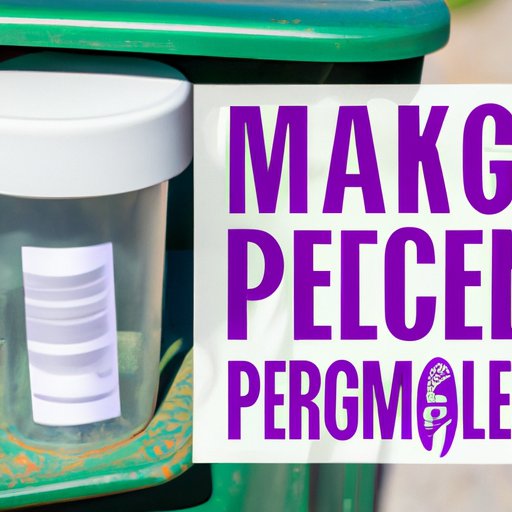
Introduction
If you’ve ever wondered what to do with medication that is no longer needed, you’re not alone. Each year, millions of Americans mismanage their medication, often by throwing it in the trash or flushing it down the toilet. The improper disposal of medicine poses significant risks to the environment and public health. Properly disposing of medication is critical to ensure a safe, healthy and sustainable environment. This article offers a comprehensive guide on how to safely dispose of medicine.
The Environmental Impact of Improper Medicine Disposal
Improper medicine disposal poses significant threats to the environment and wildlife both upstream and downstream of wastewater treatment plants. When medication is flushed down the toilet or sinks, it combines with sewage and ends up in waterways, water sources, and soil where it adversely affects the environment. Wastewater treatment facilities aren’t equipped to screen out medications, resulting in traces of drugs contaminating the environment. Exposure to these drugs can have severe implications, resulting in harm to animals, aquatic life, and humans who drink contaminated water.
Safe Disposal of Prescription Drugs at Home
One of the simplest and most effective ways of disposing of medicine is by throwing it in the trash. The essential thing to remember is to change the physical form of the medication, making it unusable and unrecognizable. This step ensures that nobody – not even those who collect trash – accidentally consumes the drugs.
The following steps should be taken for safe disposal of medication:
- Remove any personal information from the medication;
- Add water to dissolve solid medication;
- Mix medication with an undesirable substance such as coffee grounds or kitty litter;
- Place it in a sealable bag or container; and
- Dispose of it in the trash.
It is important to make sure the drugs do not end up in the wrong hands. Never give medication, especially controlled substances, to anyone without a doctor’s prescription. Keeping medication out of reach in a lockable cabinet or drawer can also help prevent unauthorized use of medication.
Recycling Programs for Unwanted Medications
Recycling programs for medication have become an increasingly popular way to dispose of unused medication safely. A recycling program involves collecting medication and redistributing it to those in need or incinerating it in an environmentally friendly way. To check whether a recycling program is available in your area, search online for local collection programs or contact your local pharmacy. The Pharmacy Locator Tool provided by the National Association of Boards of Pharmacy can also help you find a medication disposal site near you.
Drop-off Locations for Medication Disposal
Many disposal sites have drop-off locations for medication disposal. These locations offer an easy, secure, and convenient method for medication disposal by providing locations where people can drop off their unused and expired medication free of charge, so it doesn’t end up in landfills or waterways. To find a collection site near you or to inquire about whether a location is a viable option for you, contact your local law enforcement agency, pharmacy, or visit the DEA’s Diversion Control Division website.
Why Flushing Medication Down the Toilet is Harmful and Alternatives to Disposal
Flushing medication down the toilet or sink is possibly the most common method of medication disposal. However, it has severe environmental implications. Flushing medication affects the water quality and leads to the discharge of hazardous substances into the environment. The dangerous effects of these substances can persist in some cases for years. Pharmacies that sell medication provide a range of safe and easily accessible medication disposal alternatives that include medication take-back programs, mail-back programs, and drug deactivation pouches or devices.
The Role of Healthcare Providers in Educating Patients about Proper Medication Disposal
Healthcare providers have a vital role in educating patients about safe medication disposal. They should educate patients on the importance of proper medication disposal and the dangers of unsafe practices. By making medication disposal a routine part of patient safety discussions, healthcare providers can increase patient awareness and help establish safe medication disposal habits. Doctors, nurses, and pharmacists play a vital role in supporting patient safety and should always be consulted regarding the proper removal of medication.
Raising Awareness about Proper Disposal of Medication
Educating people about proper medication disposal is essential. Proper awareness leads to an environmentally safe way of disposing of medication. Raising awareness can be accomplished in various ways, such as placing flyers at local pharmacies and police departments or hosting a town hall presentation. Community awareness programs can be used to inform the public of the dangers of improper medication disposal.
Conclusion
The improper disposal of medicine poses severe threats to the environment and public health. Safe medication disposal is critical to promoting a healthy and sustainable environment. Simple steps, such as disposing of medication in the trash or at a drop-off location, can make a significant difference in reducing the contamination of drugs in waterways and landfills. The steps recommended in this article can lead to a safer, healthier, and more sustainable environment.




